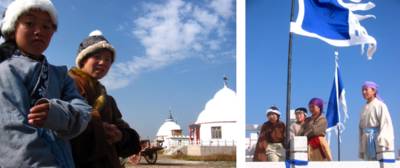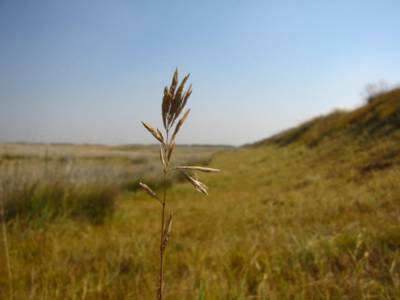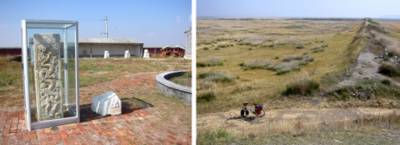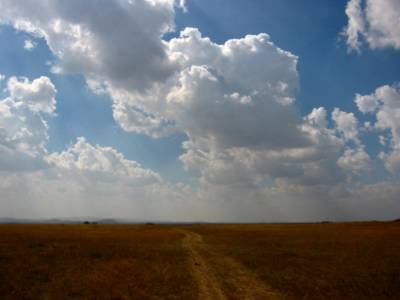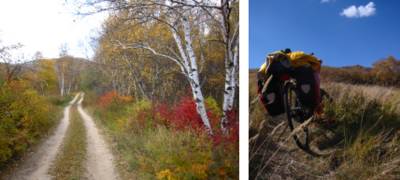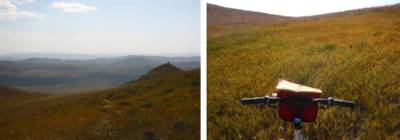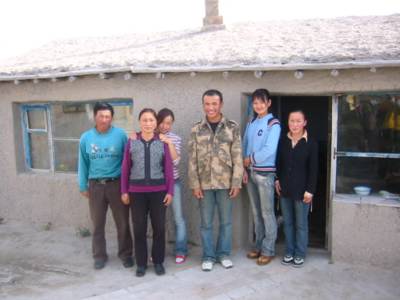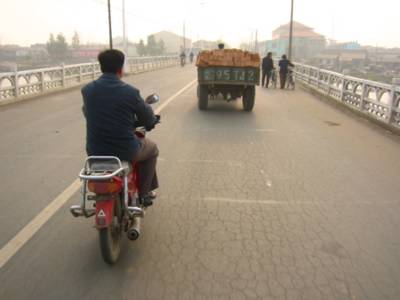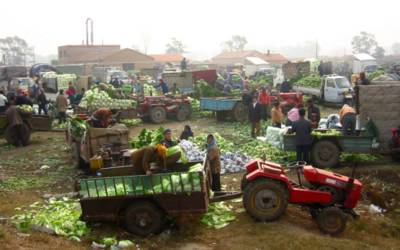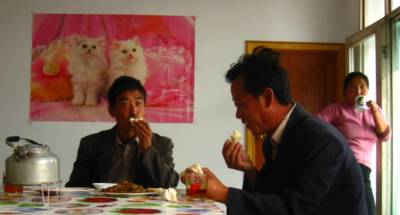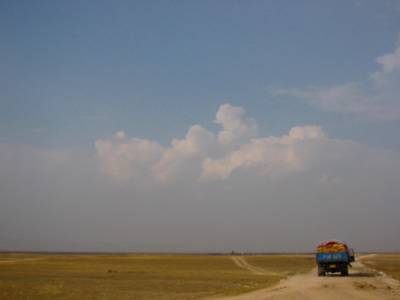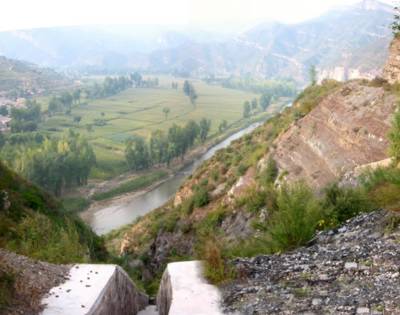heavenly grassland
bayanxilemuchang – keshiketengqi


click to load movies
heavy thunderstorms last night, slowly passing, as if they had decided to stay for the night at bayanxile's pasture home too. in the morning, a misty walk to the bathroom, the usual hole in the ground in a separate shack. my room has a big window. dreary bayanxilemuchang and its supersized “enjoy the beautiful grassland and mongolian culture” sign next to the Sinopec gass station don’t make a convincing alternative to the road ahead though – who minds some drops of rain when both a mysterious section of the great wall and dalai nur, a freshwater lake, are on the menu of the day? maybe even migrating birds along the shores of the lake, or some wild beasts? or real yurts, with real nomads, finally? I wrap feet and tent in the plastic cover of the breakfast table – soon I’m biking away, on the other side of the big window.
rain gets worse - amazing how different the grasslands look without towering blue skies. but then, as gradually as the road climbs, the rain gets lighter, up to a point it stops to bother. it’s snowing! I can’t help laughing out loud - de verplanckskes were right! back in sunny beijing, they had warned me (in onvervalst ardoois) for september snow in mongolia…

as long as I keep biking (and laughing) the cold is ok – hands and feet go into permafrost. it’s silent, almost cozy, in my grey bubble with fuzzy white dots. until an overwhelming buzz takes over from the humming of my tires… through the thick curtain appears the slender silhouette of a wind turbine, slowly making its turns… an equally undisturbed shepherd completes the surreal picture. back to the future. the shape of the earth mound in the distance seems regular enough to qualify as that forgotton part of the great wall. dalai nur is off limits.

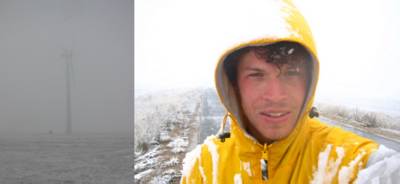

mud mound or wall of china?
pretty worn out and slightly disoriented when I manage to stop a truck. the driver pulls over, climbs on his load of coal and hoists my bike all the way up. as if he picks up bikers in blizzards all the time. my frozen hands fail to take out extra ropes to secure the bike, but he assures me it’s going to be allright.

thawing hurts, but he has cigarettes and a warm coat, and I have bulk peanuts. another cozy bubble. after noticing my bike through the cabine’s rear window, stable on a bed of coal, I fall asleep. my generous friend brings me eighty kilometers further east, to keshiketengqi, a sizeable city with sizeable puddles, down in a valley surrounded by mountains.
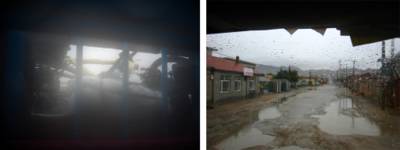
bike on coal through the rear window, and waking up in the next city

4 different sets of characters on MongolTV - cyrillic, latin, chinese, mongolian
hard to tell if here too rain turned to snow today… in any case, magic continues - at night, after winter gear shopping (shoes/gloves/socks for 15 bucks) skies are on fire, and lava creeps through the streets.
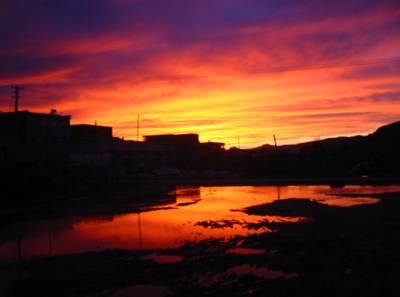



the real city of keshiketengqi feels very different from the pioneer outposts of the past week. walking around, I realize the truck drove me back to inhabited china, safely inside the wall. at the same time, chances to come across a real yurt from here are seriously shrinking - getting to know fellow nomads in inner mongolia turns out to tougher than expected… next time I’ll fix myself one of those packaged ‘stay a night in a yurt’ trips.
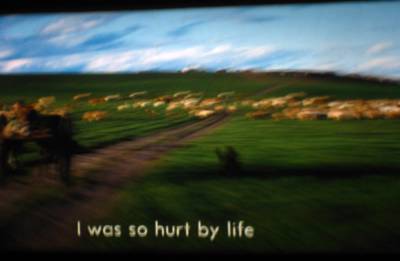
ironically, back in beijing, I will see a small independent movie called Heavenly Grassland [city boy grows up with mongolian nomad step(pe)parents in unspoilt yet harsh surroundings]. landscapes felt deja-vu, and indeed the closing credits show the movie was shot in the grasslands around keshiketengqi…


click to load movies
heavy thunderstorms last night, slowly passing, as if they had decided to stay for the night at bayanxile's pasture home too. in the morning, a misty walk to the bathroom, the usual hole in the ground in a separate shack. my room has a big window. dreary bayanxilemuchang and its supersized “enjoy the beautiful grassland and mongolian culture” sign next to the Sinopec gass station don’t make a convincing alternative to the road ahead though – who minds some drops of rain when both a mysterious section of the great wall and dalai nur, a freshwater lake, are on the menu of the day? maybe even migrating birds along the shores of the lake, or some wild beasts? or real yurts, with real nomads, finally? I wrap feet and tent in the plastic cover of the breakfast table – soon I’m biking away, on the other side of the big window.
rain gets worse - amazing how different the grasslands look without towering blue skies. but then, as gradually as the road climbs, the rain gets lighter, up to a point it stops to bother. it’s snowing! I can’t help laughing out loud - de verplanckskes were right! back in sunny beijing, they had warned me (in onvervalst ardoois) for september snow in mongolia…

as long as I keep biking (and laughing) the cold is ok – hands and feet go into permafrost. it’s silent, almost cozy, in my grey bubble with fuzzy white dots. until an overwhelming buzz takes over from the humming of my tires… through the thick curtain appears the slender silhouette of a wind turbine, slowly making its turns… an equally undisturbed shepherd completes the surreal picture. back to the future. the shape of the earth mound in the distance seems regular enough to qualify as that forgotton part of the great wall. dalai nur is off limits.



mud mound or wall of china?
pretty worn out and slightly disoriented when I manage to stop a truck. the driver pulls over, climbs on his load of coal and hoists my bike all the way up. as if he picks up bikers in blizzards all the time. my frozen hands fail to take out extra ropes to secure the bike, but he assures me it’s going to be allright.

thawing hurts, but he has cigarettes and a warm coat, and I have bulk peanuts. another cozy bubble. after noticing my bike through the cabine’s rear window, stable on a bed of coal, I fall asleep. my generous friend brings me eighty kilometers further east, to keshiketengqi, a sizeable city with sizeable puddles, down in a valley surrounded by mountains.

bike on coal through the rear window, and waking up in the next city

4 different sets of characters on MongolTV - cyrillic, latin, chinese, mongolian
hard to tell if here too rain turned to snow today… in any case, magic continues - at night, after winter gear shopping (shoes/gloves/socks for 15 bucks) skies are on fire, and lava creeps through the streets.




the real city of keshiketengqi feels very different from the pioneer outposts of the past week. walking around, I realize the truck drove me back to inhabited china, safely inside the wall. at the same time, chances to come across a real yurt from here are seriously shrinking - getting to know fellow nomads in inner mongolia turns out to tougher than expected… next time I’ll fix myself one of those packaged ‘stay a night in a yurt’ trips.

ironically, back in beijing, I will see a small independent movie called Heavenly Grassland [city boy grows up with mongolian nomad step(pe)parents in unspoilt yet harsh surroundings]. landscapes felt deja-vu, and indeed the closing credits show the movie was shot in the grasslands around keshiketengqi…















